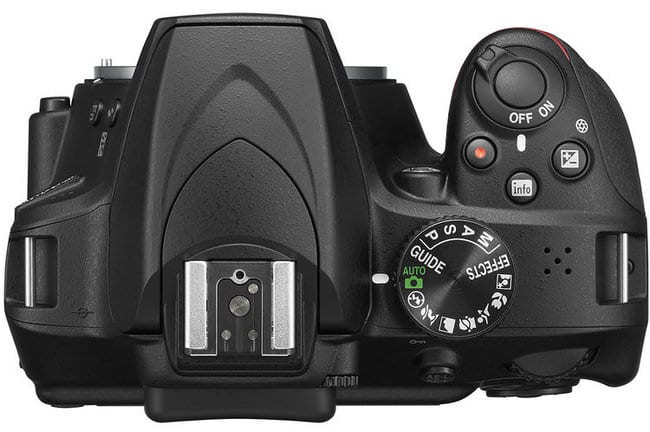- Total147
- Facebook134
- Pinterest12
- Email1

Overview
These two Nikon D series cameras are great options to get your start in photography. The Nikon D3400 and the Nikon D3500 are among Nikon’s best budget friendly, consumer-grade cameras. Both models are perfect for someone who wants a camera with interchangeable lenses, but isn’t ready to step up to a more expensive full frame or mirrorless camera.
Although Nikon rolled out the D3500 shortly after the release of the D3300, there are differences between models to know if you’re considering one of these two cameras.
One of the main differences, although not visible, is the weight of the camera. The Nikon D3500 is slightly lighter than its predecessor, 45g lighter to be exact.
Another main difference noticeable to the eye is the deeper set handgrip. This makes the D3500 more comfortable in the hand for the photographer. In addition, Nikon has rearranged the menu buttons on the back of the camera from the left to the right, adding in a LiveView switch instead of having a button for the option.
While these may not seem like a big difference from one camera model to another, they could make a difference to someone who is just starting out with a DSLR or upgrading from a smaller type of camera.
Nikon D3500

- Price Camera with 18-55mm Lens: $496.95
- Sensor: 24.2 MP DX APS-C CMOS
- Wide ISO range of 100–25600
- 5fps continuous shooting
- Improved battery life
- Improved ergonomic grip
- New button layout
- Video: 1080p video at 60fps
- Guide Mode to help new users
- 3-inch LCD screen
- Bluetooth for image transfer via Nikon’s SnapBridge app
Nikon D3400

- Price (body only): Discontinued and pricing unavailable
- Sensor: 24MP - APS-C CMOS
- ISO range: Auto, 100 - 25,600
- 5.0 fps continuous shooting
- No Anti-aliasing (AA) filter
- Nikon F Mount
- Video: 1920 x 1080 video resolution
- 3" Fixed Type Screen
- Optical (pentamirror) viewfinder
- Size - 395g, 124 x 98 x 76 mm
Nikon D3400 pros:
The Nikon D3400’s design made it a good step up for beginners without breaking the bank. It offered many new features compared to its predecessor, the D3300. like built in guide-mode, longer lasting battery life, ISO range of ISO100 to ISO25600, and Bluetooth image transfer via the company’s Snapbridge app.
Released in 2016, the camera has received many great reviews on its image quality. A 24 megapixel sensor with its anti-aliasing filter creates the sharp images Nikon is known for. For an APS-C sensor, the D3400 does a good job controlling excess noise.
The camera lacks a few ‘nice-to-have’ features; however, for a DSLR of this size and price point, it’s a great value.

Nikon D3500 pros:
The successor to the Nikon D3400, the D3500 is visually more compact than the Nikon D3400. Nikon has moved the menu buttons on the back of the camera to make shooting more comfortable. This allows the photographer to reach them more quickly and easily than was possible with the D3400.
You’ll also notice that with the battery and card inserted, the camera weighs less than its older counterpart. Nikon also gave the D3500 a deeper set handgrip, which means more comfort when holding the camera and using the Live View in particular.
It’s compact size might have you pressing your nose up against the LCD screen when you use the viewfinder, but it also makes for a nice transition from a point-and-shoot camera or a smartphone..
The battery is also said to last longer than its older sibling. At full charge, you’ll get 350 shots more than the D3400, making this D3500’s most resounding difference and a definite upgrade from its predecessor.
Not having to worry about extra batteries and shooting up to 1500 shots on a single charge makes this “upgrade” well worth it, given the price point of D3500.
Except for that, the D3500 has only a few differences from the D3400. None of these changes really affect the camera’s image quality or handling.

What they both have:
Both the D3400 and D3500 have a very similar build, and you’ll notice that all the key features are similar as well. From the sensor and processor, to the image quality output, even the 24 megapixel sensors are the same.
With Nikon’s fourth generation processor, the EXEED 4, it gives both cameras the capability to shoot with nicely rich and detailed images that are good quality in beginning DSLR camera models.
Both the D3400 and D3500 have Full HD 1920×1080 pixels video clips, including being able to achieve a maximum video frame rate of up to 59.94fps; the other options being 50fps, 29.97fps, 25fps and 23.976fps. This makes both great choices for the amateur videographer.
The cameras also have tiny built in mono microphones. The audio quality from these built-in mics isn’t nearly as good as what an external microphone provides. Taking that into account, the camera designs for both the D3400 and D3500 do not include an external microphone port. So expect tinny audio quality from either camera.
In terms of the AF system, Nikon didn’t change a thing across the two models. The two cameras share the same 11 selectable focus points and one cross type sensor. Making both models pretty much in line with other DSLRs within the same price point.
Nikon claims that that the D3500 will capture your subjects in sharp focus, even with the same AF system as the D3400.
The D3400, and its newer counterpart the D3500, have a wide ISO range of ISO 100 and ISO 25,600. Both models omitted a low-pass filter, which allows the cameras to deliver good detail even in the high ISO ranges.
Each model also kept the Picture Controls that allow the photographer to add an effect or selective “look” to their images. Picture Controls included are namely, Super Vivid, Illustration and Toy Camera.
The lack of WiFi capability in these cameras is a big miss from Nikon, since they have only included Bluetooth capability for both the D3400 and the D3500. However, with Nikon’s Snapbridge app, both cameras can transfer images without a cable. This allows for easy image sharing and transfer across devices.


What both lack:
Since both of the cameras are in the budget-friendly amateur photographer category, it’s not surprising that the cameras lack certain features you’d usually find in more expensive camera models.
Both models have a 3” LCD screen, with no tilting capabilities. This makes these cameras restrictive to shoot in Live View mode for more creative angles. The cameras’ LCD screens aren’t touch screens, either. This is a shame as Nikon will lose buyers to other budget friendly cameras who offer that feature.
Neither model, the D3400 and D3500, comes with in-body image stabilization. It might be worth it to invest in Nikon’s line of image stabilization lenses to overcome this deficit. Nikon’s image stabilization lenses feature “VR” (vibration reduction) to signify these lenses.
Which one wins?
The two cameras both feature 24-megapixel APS crop sensors, are compatible with F mount lenses, 11 point selectable AF system, Full HD video. Both models can use Nikon F-mount lenses. While both cameras can shoot 4k video, neither can shoot full HD video. Both models share the same ISO range and image quality Nikon is known for.
Although the D3500 is slightly newer and more compact, the two cameras are much the same.
Nikon didn’t really change much for the newer D3500 other than its barely noticeable weight reduction and longer lasting battery life, keeping much of the key features the same as the D3400.
One deciding factor when choosing between the two is that the D3500 is newer in terms of release date. However, the real determiner will be which one you can snag for less, since they are almost identical in all other ways.
If you’re ready to start pursuing YOUR photography dreams today, check out my FREE training that will equip you to Show Your Camera Who’s Boss. People who take my training walk away a more confident camera user and better photographer Join me on my free training and learn how to show your camera who’s boss.
- Total147
- Facebook134
- Pinterest12
- Email1






2 thoughts on “Nikon D3400 vs. Nikon D3500”
I’ve always desired a Leica M camera, but it’s not the sort of camera for a novice like the D3500. With the Leica in mind I have decided to practice with the D3500 and a Nikon 28mm f2.8d lens. By turning on the rangefinder in the menu I am able to focus, set speed on the camera with the aperture setting on the lens. The exposure is by a Leningrad4 meter and away I go.
If you are careful with exposure (Ansel Adams style) you can get great results. I’ve since purchased a Nikon 28mm 1.8 G lens because I like the focal length but prefer the slow careful way to get the best shots. It’s a great camera and I love it.
Thanks for sharing, Mike!